Dr Sukhjinder Nijjer
Consultant Cardiologist
Expert in Pacemaker Implantation
Contact us for more information
Pacemakers Explained
What are Pacemakers?
Pacemakers are small medical devices, typically smaller than a pack of matches, that are connected to two ‘leads’ or ‘wires’ that travel through veins into the right side of the heart.
Pacemaker devices continuously monitor the heart rhythm (the electrical activity that drives every single heart beat). When it detects there are certain types of slow heart rhythm, then the pacemaker will provide electrical stimulation to the heart muscle. The electrical stimulation is delivered via the ‘lead’ that is placed in the right ventricle.
Most modern pacemakers are ‘dual chamber’ devices. This means there are ‘leads’ that are placed in the right atrium and the right ventricle. This means they have can have control over both the upper chambers of the heart (the atria) and the lower chambers of the heart (the ventricles). This allows better co-ordination of the two parts of the heart.
In some patients, typically with permanent atrial fibrillation, or in very frail older patients, a single chamber device may be used. In this situation, there is only a lead to the right ventricle.
You should be able to feel when the pacemaker is working. Most of it’s efforts are entirely silent and go unnoticed. Once the device is placed and has settled in, you should be able to do most activities without any major limitation. The device will work within miliseconds and will stop problems related to slow heart rates. In some cases, it can completely take over the electrical signalling of the heart.

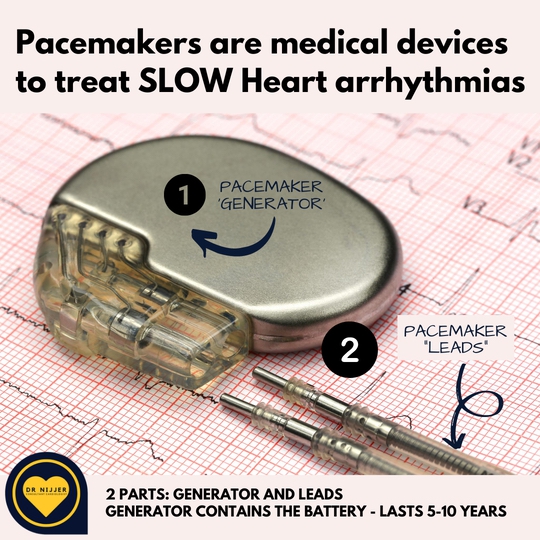
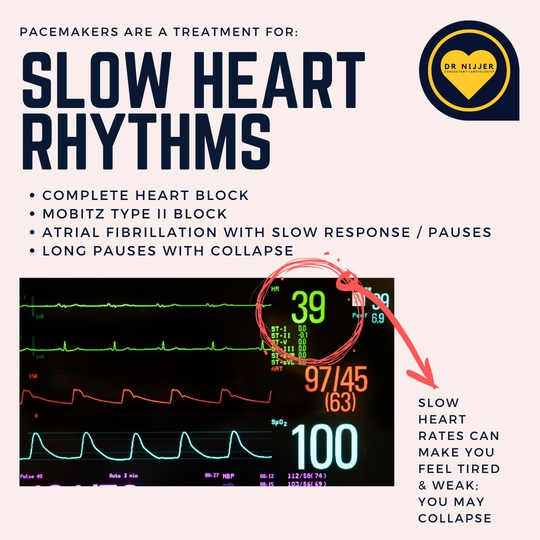
Common Reasons for Pacemakers
Slow heart rates and ‘cardiac pauses’ are the main reasons for having a pacemaker. Patients may be feel dizzy spells or even have collapsing episodes. ECGs and ECG monitors, such as Holter monitors or ZioPatch devices, may capture evidence of very slow heart rates. Importantly, there must be a correlation between symptoms and the ECGs recorded. Patients with pauses that exceed 3 seconds with symptoms may be considered for a pacemaker. In those patients with pauses occurring at night, we may consider 6 seconds as the indicator for a pacemaker.
In some circumstances, the electrical signalling within the heart can ‘wear out’. In this situation, the signals between the atrium and ventricle can become disrupted. Patients may have sudden episodes of dizzy spells and fainting. If there is electrical dissociation between the atrium and ventricle, then we call this ‘complete heart block’. Despite it’s name, this does not mean an artery is blocked. Patients with this condition typically need a pacemaker implanted very urgently and will need emergency admission to hospital.
Learn about ECG monitoring here
Pacemaker Implantation
Pacemakers are typically implanted on the left hand side, although in some left-handed patients, we can use the right side of the body. The procedure can be Day-Case or require a single over night stay.
Prior to the procedure, blood tests are required to check for the blood clotting and to ensure there is no infection. If you are taking blood thinning medication, then you should inform Dr Nijjer. Generally, Aspirin, Clopidogrel, Ticagrelor or Prasugrel is not a major issue and should be continued even on the day of the procedure unless you are instructed otherwise. In general, medicines such as Rivaroxaban or Apixaban may be need to be stopped for 1 day prior to the procedure. Older blood thinners such as Warfarin will need a case-by-case discussion. For those patients with metallic valve replacements, Dr Nijjer will perform the procedure without stopping the Warfarin.
The procedure is performed while the patient is awake but some light sedation may be given to make the process comfortable. Intravenous antibiotics are given to reduce the chance of infection. The procedure will be performed with the patient thoroughly cleaned and the chest sterilised. It is advisable to wash thoroughly before the procedure. There will be a smaller 3-4cm cut made below the collar bone (‘clavicle’) which will be carefully closed and sutured. In general, the scar heals well but care must be taken to avoid touching it to prevent infection.
Once the incision is made, the leads are placed within the heart. In some cases, this can be the longest part of the procedure as finding the best place for the pacemaker leads will determine how well the device will work going forward. The leads are placed under X-ray guidance throughout the procedure.
Once everything is fully positioned, the device will be checked before the end of the procedure to ensure all is working well.
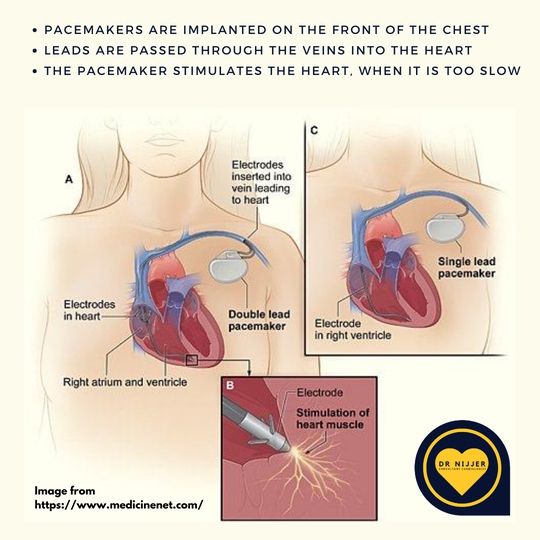

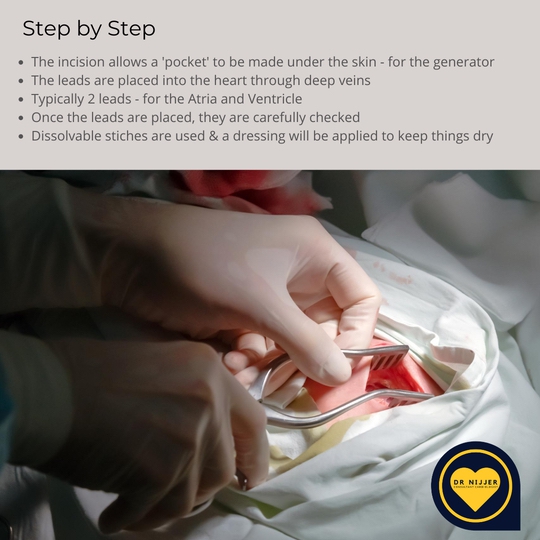
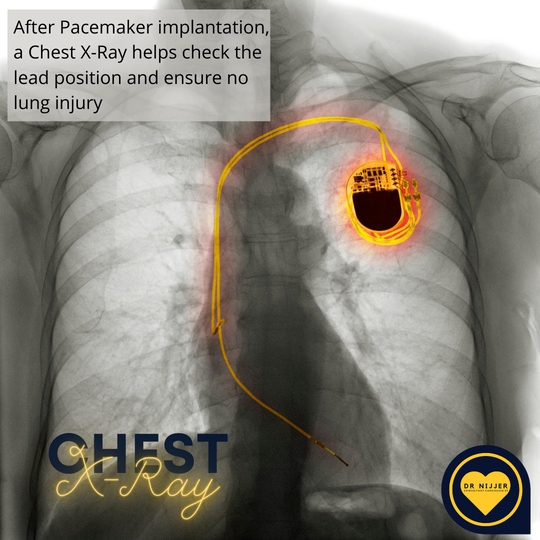
After Pacemaker Implantation
Immediately after a pacemaker implantation, the chest will be sore and uncomfortable. We can provide strong pain relief to help improve this. There can be bruising over the incision site and sometimes this shows up after several days.
After the pacemaker, a chest radiograph (‘X-ray’) will be taken. This is to ensure the pacemaker leads are in the right position. It also helps to exclude any injury to the lungs. The lungs are immediately below the veins used to access the heart, and in some cases, the needle can cause the lung to partially collapse. If this were to occur, a small drain is typically placed in the chest wall to allow the lung to re-inflate over a day or so.
The pacemaker device is checked using special devices that are held over the chest. This will be done either on the day of the procedure, or the following day. Further checks will be performed in a few weeks and then at 6 months. If all is well, the device can then be checked on a yearly interval.
We ask you to rest the arm closest to the pacemaker – typically the left arm. In general, we advise you behaving as if that arm is broken or injured for 6 weeks. While the arm and hand can be used, we wish you to avoid raising the arm above the level of the shoulder. This is because large movements can displace the pacemaker leads. After 6 weeks, there is sufficient healing to allow much more normal movement and the risk of displacement drops significantly.
Potential Complications
All procedures have potential complications. The principle issues are the possibility of bruising and bleeding at the incision site. Compression bandages after the procedure can help but some bruising is inevitable if the procedure is performed while the patient is taking blood thinning medication.
There is a risk of infection. The procedure is performed under sterile conditions and great efforts are made to minimise the risk of infection but it can still occur. In some cases, the wound can become infected after the procedure and great care and attention is required to prevent this. If there is infection of the skin, then strong antibiotics will be needed. A major concern is if the device itself becomes infected and, if this occurs, then a complex regimen of antibiotics and removal of the device will be necessary.
There isa risk of a punctured lung (‘pneumothorax’) – this is because the lung sits a few millimetres below some of the veins used to access the heart. This means the lungs can be punctured by the long needles used. If this occurs, a drain is required to re-inflate the lung.
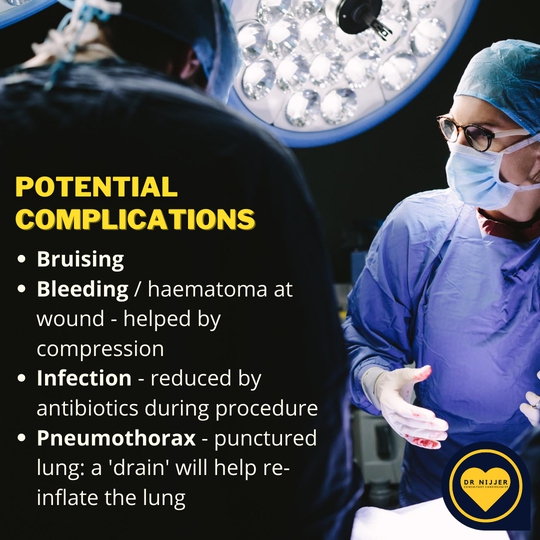

Longer Term
Once the device has settled in and all the checks demonstrate normal function, then we would expect you to continue with your normal activity.
In some thin people, the device can appear prominent on the chest well. We advise that you avoid ‘fiddling’ with the device – in some case, people are known to pull on the device and this can cause the leads to be retracted and the pacemaker to stop working.
If you lose a lot of weight, the pacemaker can become more prominent in it’s appearance. If the skin becomes very thin, the device could start to push through the skin but this is fairly rare.
Help Your Heart
If you have any concerns regarding your heart health, then please seek a referral to Dr Nijjer.
Call the Team: Monika, Amy, Charlotte, Erin or Grace:
0203 9838 001
Email: Secretary@DrNijjer.com
Dr Nijjer can be seen at :
68 Harley Street, London, W1G 9QP
He also practices at Cromwell Hospital, Wellington Hospital, BUPA Clinics, BMI Syon Clinic as well as Imperial Private Healthcare.

